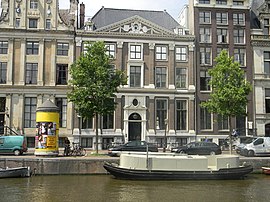Het Grachtenhuis
Het Grachtenhuis (literally: The Canal House ) is a museum on Amsterdam's Herengracht and is one of the best preserved canal houses in Amsterdam from the 17th century. The museum provides information about the formation and development of the Amsterdam Canal Belt . It was opened to the public in 2011.
history
The building was built between 1663 and 1665 by order of the Dutch merchant Karel Gerard. The design comes from the Dutch architect Philips Vingboons . Well-known merchants and bankers used to live in the "Haus an der Gracht ". Among others, Jan Willink (1831–1896) in 1791, Nicolaes van Bambeeck (1596–1661) in 1690, Cornelis Munter (1652–1708) in 1741 and Pieter Pels Andriesz in 1735. Significant transactions took place in the Grachtenhuis. With the Russian aristocracy , with French kings and the American " upper class ".
Around three million tourists and locals visit the “Canal Belt” (a UNESCO World Heritage Site) every year and the museum offers a digital historical “journey of discovery” over 400 years of history in 45 minutes with animations and 3D projects in five rooms (kamers) . For the multimedia presentation, the visitors receive headphones , whereby information is automatically passed on in eight different languages when entering the individual rooms.
All Rijksmonumente from the inner city, the "canal belt", are shown, whereby the main feature is the architectural history, with numerous photos of the canal houses and their historical interior design . Currently (as of early 2013) the “digital Grachtenhuis” contains 9,686 objects of buildings, 5,288 images and 5,484 objects with images.
The museum has a souvenir shop with, among other things, books, wine and jewelry, all of which are related to the Amsterdam “Canal Belt” and the Canal House. There is a passenger elevator for wheelchair users, among others. The museum is also officially authorized by the municipality of Amsterdam to provide a room for weddings.
The museum is financed from private funds and entrance fees and is a listed building (Rijksmonument No. 1828).
literature
- E. van Houten: GRACHTENBOEK. Canal boek naar de oorspr. tekeningen van Caspar Philips Jacobszoon (Van Amsterdam) . Uitgeverij Gemeente Amsterdam, 1962.
Transport links
The museum can be reached by the Amsterdam tram lines (Tramlijn, Tram) number 1, 2, and 5. Stop at Koningsplein ( Bloemenmarkt ). From there on foot to the nearby Herengracht.
See also
Web links
- Homepage (English)
- Het Grachtenhuis (the canal house) . In: iamsterdam.com
- The Canal House in Amsterdam . In: holland.com
Individual evidence
- ^ Nieuws uit Amsterdam . News from Amsterdam . From March 30th 2011. Via Het Grachtenhuis . Dutch, accessed February 4, 2013
- ^ History of Het Grachtenhuis . Dutch, accessed February 4, 2013
- ↑ Other sources write of six and seven rooms and of 40 minutes of digital "voyage of discovery"
- ↑ Information about Het Grachtenhuis ( page no longer available , search in web archives ) Info: The link was automatically marked as defective. Please check the link according to the instructions and then remove this notice. . Dutch, accessed February 4, 2013
- ↑ Database of the Amsterdam Canal Cord . Dutch, accessed February 4, 2013
- ↑ Het Grachtenhuis Amsterdam . By: Amsterdam Oude Stad . With map. Dutch, accessed February 4, 2013
- ^ Het Grachtenhuis ( Memento of March 5, 2016 in the Internet Archive ). Rijksmonument, monument no .: 1828
Coordinates: 52 ° 22 '4.38 " N , 4 ° 53' 10.47" E
